Spatial-Temporal Characteristics of Multi-Hazard Resilience in Ecologically Fragile Areas of Southwest China: A Case Study in Aba
Abstract
1. Introduction
2. Materials and Methods
2.1. Research Area
2.2. Data Sources
2.3. Measurement Methods
2.3.1. Resilience Calculation
2.3.2. Global Entropy Weight
2.3.3. Exploratory Spatial Data Analysis (ESDA)
2.3.4. Partial Least Squares (PLS) Regression
2.3.5. DROP Model
2.3.6. Selection of Indicators
3. Results
3.1. The Changing Trend of Disaster Resilience in Aba
3.2. Temporal Variation of Disaster Resilience in 13 Counties
3.3. Spatial Variation in Disaster Resilience in 13 Counties
3.4. Influencing Factors of Disaster Resilience
4. Discussion and Recommendations
4.1. Discussion
4.2. Policy Recommendations
5. Conclusions
Author Contributions
Funding
Institutional Review Board Statement
Informed Consent Statement
Data Availability Statement
Acknowledgments
Conflicts of Interest
References
- Huang, P.; Pan, H.; Peng, L.; Chen, T.; Xu, J. Temporal and spatial variation characteristics of disaster resilience in Southwest China’s mountainous regions against the background of urbanization. Nat. Hazards 2020, 103, 3783–3802. [Google Scholar] [CrossRef]
- Docherty, J.M.; Mao, F.; Buytaert, W.; Clark, J.R.; Hannah, D.M. A framework for understanding water-related multi-hazards in a sustainable development context. Prog. Phys. Geogr. 2020, 44, 267–284. [Google Scholar] [CrossRef]
- Group, W. Hazards of Nature, Risks to Development: An IEG Evaluation of World Bank Assistance for Natural Disasters; World Bank Publications: Washington, DC, USA, 2006. [Google Scholar]
- Wahlström, M. New Sendai Framework Strengthens Focus on Reducing Disaster Risk. Int. J. Disaster Risk Sci. 2015, 6, 200–201. [Google Scholar] [CrossRef]
- Parsons, M.; Reeve, I.; McGregor, J.; Hastings, P.; Marshall, G.R.; McNeill, J.; Stayner, R.; Glavac, S. Disaster resilience in Australia: A geographic assessment using an index of coping and adaptive capacity. Int. J. Disaster Risk Reduct. 2021, 62, 102422. [Google Scholar] [CrossRef]
- Norris, F.H.; Stevens, S.P.; Pfefferbaum, B.; Wyche, K.F.; Pfefferbaum, R.L. Community Resilience as a Metaphor, Theory, Set of Capacities, and Strategy for Disaster Readiness. Am. J. Commun. Psychol. 2008, 41, 127–150. [Google Scholar] [CrossRef] [PubMed]
- Cutter, S.L.; Burton, C.G.; Emrich, C.T. Disaster resilience indicators for benchmarking baseline conditions. J. Homel. Secur. Emerg. Manag. 2010, 7, 51. [Google Scholar] [CrossRef]
- Kato, K. Debating sustainability in tourism development: Resilience, traditional knowledge and community: A post-disaster perspective. Tour. Plan. Dev. 2018, 15, 55–67. [Google Scholar] [CrossRef]
- Javadpoor, M.; Sharifi, A.; Roosta, M. An adaptation of the Baseline Resilience Indicators for Communities (BRIC) for assessing resilience of Iranian provinces. Int. J. Disaster Risk Reduct. 2021, 66, 102609. [Google Scholar] [CrossRef]
- Meng, H.; Zhang, Y.Q.; Yang, L. Spatial distribution of geological hazards in the middle section of the eastern margin of the Qinghai-Tibet Plateau. Geol. China 2004, 31, 218–224. [Google Scholar]
- Bixler, R.P.; Yang, E.; Richter, S.M.; Coudert, M. Boundary crossing for urban community resilience: A social vulnerability and multi-hazard approach in Austin, Texas, USA. Int. J. Disaster Risk Reduct. 2021, 66, 102613. [Google Scholar] [CrossRef]
- Cai, H.; Lam, N.S.; Qiang, Y.; Zou, L.; Correll, R.M.; Mihunov, V. A synthesis of disaster resilience measurement methods and indices. Int. J. Disaster Risk Reduct. 2018, 31, 844–855. [Google Scholar] [CrossRef]
- Xu, H.; Li, Y.; Tan, Y.; Deng, N. A scientometric review of urban disaster resilience research. Int. J. Environ. Res. Public Health 2021, 18, 3677. [Google Scholar] [CrossRef]
- Holling, C.S. Resilience and stability of ecological systems. Annu. Rev. Ecol. Syst. 1973, 4, 1–23. [Google Scholar] [CrossRef]
- Mileti, D. Disasters by Design: A Reassessment of Natural Hazards in the United States; Joseph Henry Press: Washington, DC, USA, 1999. [Google Scholar]
- Peng, C.; Yuan, M.; Gu, C.; Peng, Z.; Ming, T. A review of the theory and practice of regional resilience. Sustain. Cities Soc. 2017, 29, 86–96. [Google Scholar] [CrossRef]
- Mavhura, E.; Manyangadze, T.; Aryal, K.R. A composite inherent resilience index for Zimbabwe: An adaptation of the disaster resilience of place model. Int. J. Disaster Risk Reduct. 2021, 57, 102152. [Google Scholar] [CrossRef]
- Chen, X.; Quan, R. A spatiotemporal analysis of urban resilience to the COVID-19 pandemic in the Yangtze River Delta. Nat. Hazards 2021, 106, 829–854. [Google Scholar] [CrossRef]
- Chang, S.E.; Shinozuka, M. Measuring improvements in the disaster resilience of communities. Earthq. Spectra 2004, 20, 739–755. [Google Scholar] [CrossRef]
- Fang, Y.; Zhu, F.; Qiu, X.; Zhao, S. Effects of natural disasters on livelihood resilience of rural residents in Sichuan. Habitat Int. 2018, 76, 19–28. [Google Scholar] [CrossRef]
- Cutter, S.L.; Derakhshan, S. Temporal and spatial change in disaster resilience in US counties, 2010–2015. Environ. Hazards 2020, 19, 10–29. [Google Scholar] [CrossRef]
- Cutter, S.L.; Barnes, L.; Berry, M.; Burton, C.; Evans, E.; Tate, E.; Webb, J. A place-based model for understanding community resilience to natural disasters. Glob. Environ. Chang. 2008, 18, 598–606. [Google Scholar] [CrossRef]
- Tena-Colunga, A.; Hernández-Ramírez, H.; Godínez-Domínguez, E.A.; Pérez-Rocha, L.E. Mexico City during and after the September 19, 2017 earthquake: Assessment of seismic resilience and ongoing recovery process. J. Civ. Struct. Health Monit. 2021, 11, 1275–1299. [Google Scholar] [CrossRef] [PubMed]
- Ruan, J.; Chen, Y.; Yang, Z. Assessment of temporal and spatial progress of urban resilience in Guangzhou under rainstorm scenarios. Int. J. Disaster Risk Reduct. 2021, 66, 102578. [Google Scholar] [CrossRef]
- Zhang, X.; Song, J.; Peng, J.; Wu, J. Landslides-oriented urban disaster resilience assessment—A case study in ShenZhen, China. Sci. Total Environ. 2019, 661, 95–106. [Google Scholar] [CrossRef] [PubMed]
- Deuge, J.; Hoang, H.; Kent, K.; Mond, J.; Bridgman, H.; Skromanis, S.; Smith, L.; Auckland, S. Impacts of community resilience on the implementation of a mental health promotion program in rural Australia. Int. J. Environ. Res. Public Health 2020, 17, 2031. [Google Scholar] [CrossRef]
- Liu, X.; Li, S.; Xu, X.; Luo, J. Integrated natural disasters urban resilience evaluation: The case of China. Nat. Hazards 2021, 107, 2105–2122. [Google Scholar] [CrossRef]
- Chen, Y.; Su, X.; Zhou, Q. Study on the spatiotemporal evolution and influencing factors of urban resilience in the Yellow River basin. Int. J. Environ. Res. Public Health 2021, 18, 10231. [Google Scholar] [CrossRef]
- Chen, Y.; Zhu, M.; Zhou, Q.; Qiao, Y. Research on spatiotemporal differentiation and influence mechanism of urban resilience in China based on MGWR model. Int. J. Environ. Res. Public Health 2021, 18, 1056. [Google Scholar] [CrossRef]
- Shi, T.; Qiao, Y.; Zhou, Q.; Zhang, J. The regional differences and random convergence of urban resilience in China. Technol. Econ. Dev. Econ. 2022, 28, 979–1002. [Google Scholar] [CrossRef]
- Alberti, M.; Marzluff, J.M.; Shulenberger, E.; Bradley, G.; Ryan, C.; Zumbrunnen, C. Integrating humans into ecology: Opportunities and challenges for studying urban ecosystems. Bioscience 2003, 53, 1169–1179. [Google Scholar] [CrossRef]
- Huang, G.; Li, D.; Zhu, X.; Zhu, J. Influencing factors and their influencing mechanisms on urban resilience in China. Sustain. Cities Soc. 2021, 74, 103210. [Google Scholar] [CrossRef]
- Li, M.; Sun, H.; Agyeman, F.O.; Heydari, M.; Jameel, A.; Khan, H.S.U.D. Analysis of Potential Factors Influencing China’s Regional Sustainable Economic Growth. Appl. Sci. 2021, 11, 10832. [Google Scholar] [CrossRef]
- Koliou, M.; van de Lindt, J.W.; McAllister, T.P.; Ellingwood, B.R.; Dillard, M.; Cutler, H. State of the research in community resilience: Progress and challenges. Sustain. Resilient Infrastruct. 2020, 5, 131–151. [Google Scholar] [CrossRef]
- Aksha, S.K.; Emrich, C.T. Benchmarking community disaster resilience in Nepal. Int. J. Environ. Res. Public Health 2020, 17, 1985. [Google Scholar] [CrossRef]
- Tan, J.; Peng, L.; Guo, S. Measuring household resilience in hazard-prone mountain areas: A capacity-based approach. Soc. Indic. Res. 2020, 152, 1153–1176. [Google Scholar] [CrossRef]
- Sajjad, M.; Chan, J.C.; Chopra, S.S. Rethinking disaster resilience in high-density cities: Towards an urban resilience knowledge system. Sustain. Cities Soc. 2021, 69, 102850. [Google Scholar] [CrossRef]
- Cui, K.; Han, Z.; Wang, D. Resilience of an earthquake-stricken rural community in southwest China: Correlation with disaster risk reduction efforts. Int. J. Environ. Res. Public Health 2018, 15, 407. [Google Scholar] [CrossRef]
- Schickhoff, U.; Bobrowski, M.; Böhner, J.; Bürzle, B.; Chaudhary, R.P.; Gerlitz, L.; Lange, J.; Müller, M.; Scholten, T.; Schwab, N. Climate change and treeline dynamics in the Himalaya. In Climate Change, Glacier Response, and Vegetation Dynamics in the Himalaya; Springer: Berlin/Heidelberg, Germany, 2016; pp. 271–306. [Google Scholar]
- Wester, P.; Mishra, A.; Mukherji, A.; Shrestha, A.B. The Hindu Kush Himalaya Assessment: Mountains, Climate Change, Sustainability and People; Springer Nature: Singapore, 2019. [Google Scholar]
- Tian, C.; Fang, Y.; Yang, L.E.; Zhang, C. Spatial-temporal analysis of community resilience to multi-hazards in the Anning River basin, Southwest China. Int. J. Disaster Risk Reduct. 2019, 39, 101144. [Google Scholar] [CrossRef]
- Zhang, Y.; Jia, R.; Wu, J.; Wang, H.; Luo, Z. Evaluation of Groundwater Using an Integrated Approach of Entropy Weight and Stochastic Simulation: A Case Study in East Region of Beijing. Int. J. Environ. Res. Public Health 2021, 18, 7703. [Google Scholar] [CrossRef]
- Liu, K.; Ni, Z.; Ren, M.; Zhang, X. Spatial Differences and Influential Factors of Urban Carbon Emissions in China under the Target of Carbon Neutrality. Int. J. Environ. Res. Public Health 2022, 19, 6427. [Google Scholar] [CrossRef]
- Messner, S.F.; Anselin, L.; Baller, R.D.; Hawkins, D.F.; Deane, G.; Tolnay, S.E. The spatial patterning of county homicide rates: An application of exploratory spatial data analysis. J. Quant. Criminol. 1999, 15, 423–450. [Google Scholar] [CrossRef]
- Wang, L.; Feng, Z.; Yang, Y. The change in population density from 2000 to 2010 and its influencing factors in China at the county scale. J. Geogr. Sci. 2015, 25, 485–496. [Google Scholar] [CrossRef]
- Yang, Y.; Zhao, T.; Wang, Y.; Shi, Z. Research on impacts of population-related factors on carbon emissions in Beijing from 1984 to 2012. Environ. Impact Assess. Rev. 2015, 55, 45–53. [Google Scholar] [CrossRef]
- Zhou, H.; Wang, J.A.; Wan, J.; Jia, H. Resilience to natural hazards: A geographic perspective. Nat. Hazards 2010, 53, 21–41. [Google Scholar] [CrossRef]
- Cardoni, A.; Noori, A.Z.; Greco, R.; Cimellaro, G.P. Resilience assessment at the regional level using census data. Int. J. Disaster Risk Reduct. 2021, 55, 102059. [Google Scholar] [CrossRef]
- Rifat, S.A.A.; Liu, W. Measuring community disaster resilience in the conterminous coastal United States. ISPRS Int. J. Geo-Inf. 2020, 9, 469. [Google Scholar] [CrossRef]
- Bruneau, M.; Chang, S.E.; Eguchi, R.T.; Lee, G.C.; O’Rourke, T.D.; Reinhorn, A.M.; Shinozuka, M.; Tierney, K.; Wallace, W.A.; Von Winterfeldt, D. A framework to quantitatively assess and enhance the seismic resilience of communities. Earthq. Spectra 2003, 19, 733–752. [Google Scholar] [CrossRef]
- Cutter, S.L.; Ash, K.D.; Emrich, C.T. The geographies of community disaster resilience. Glob. Environ. Chang. 2014, 29, 65–77. [Google Scholar] [CrossRef]
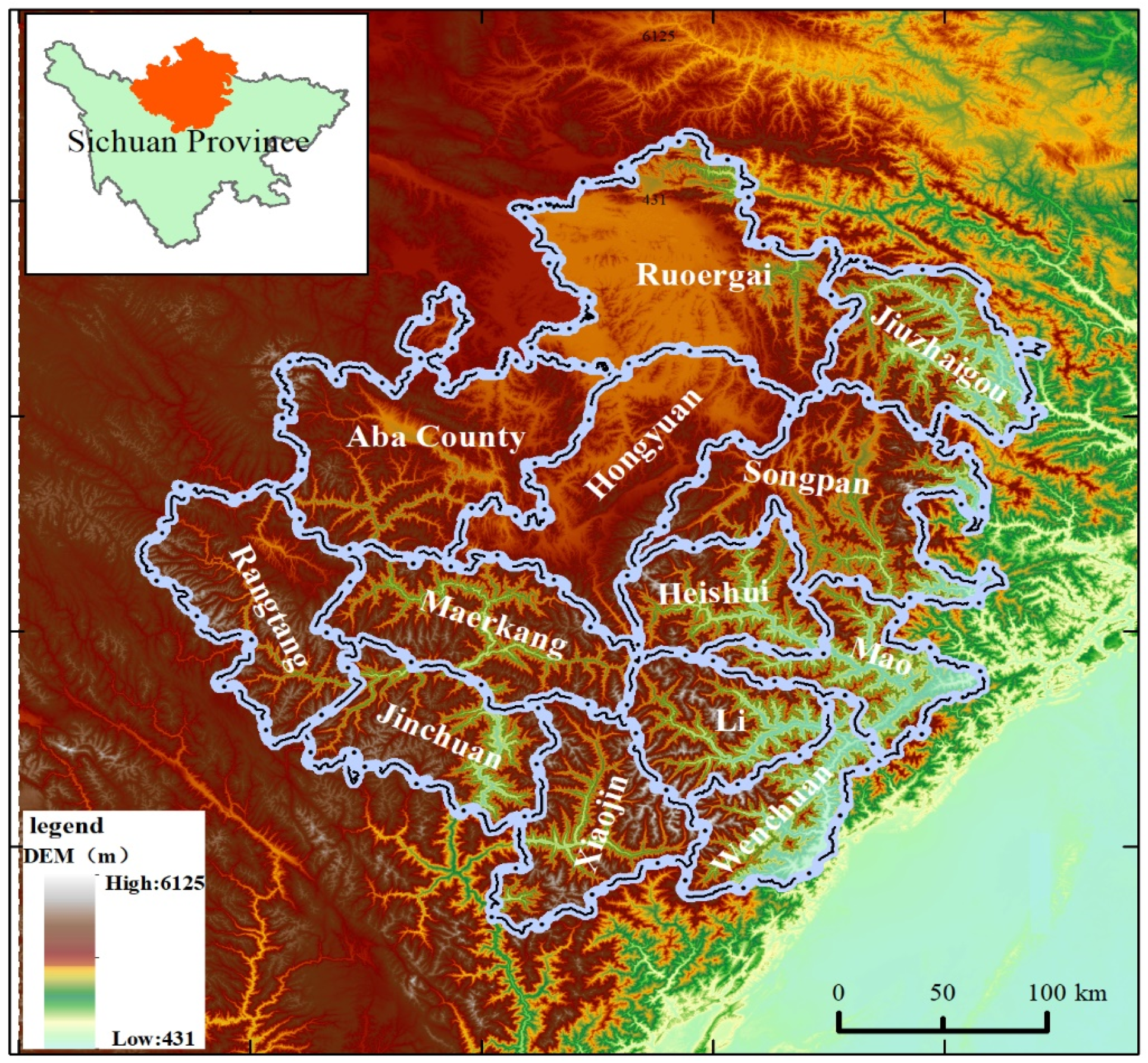

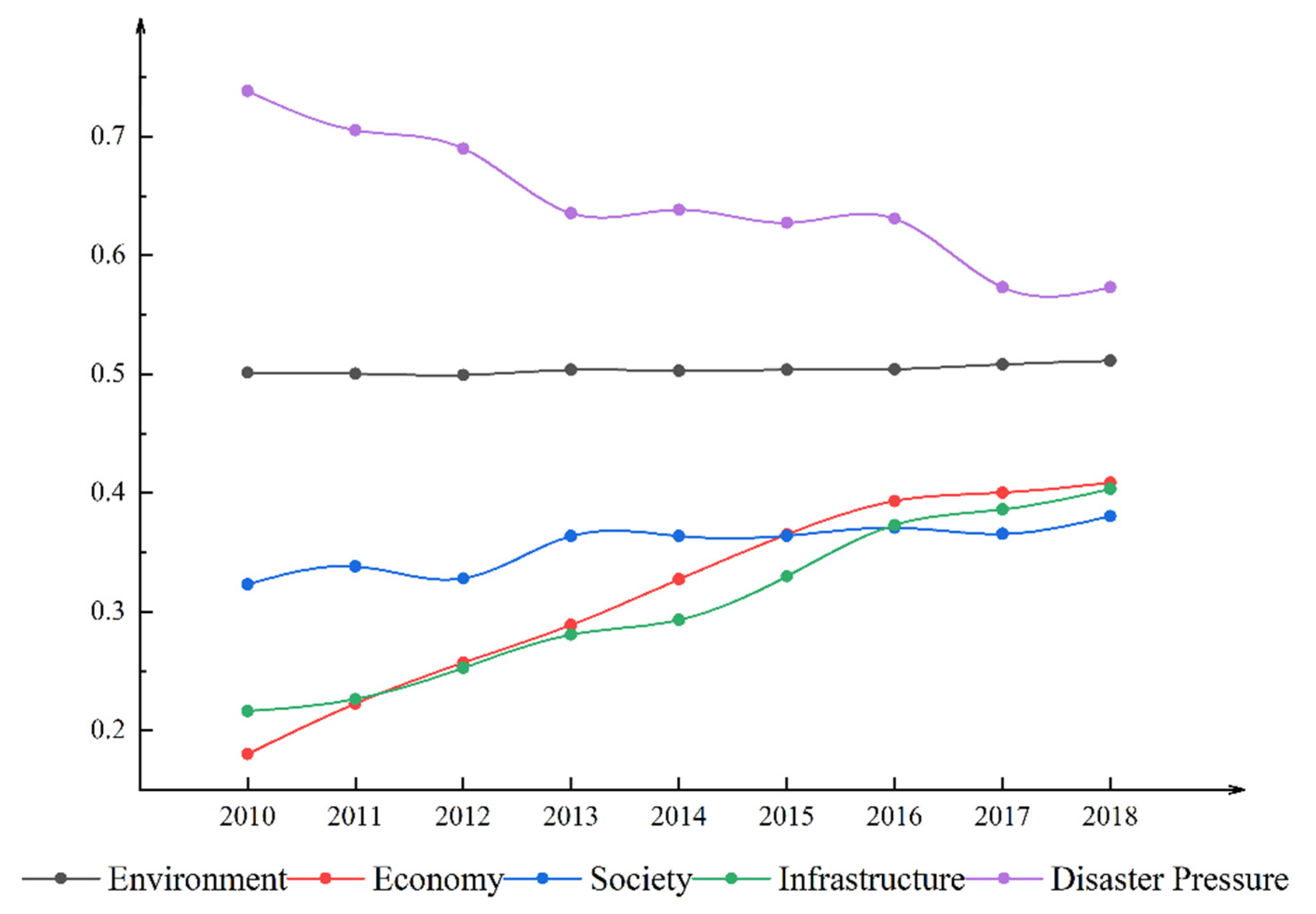
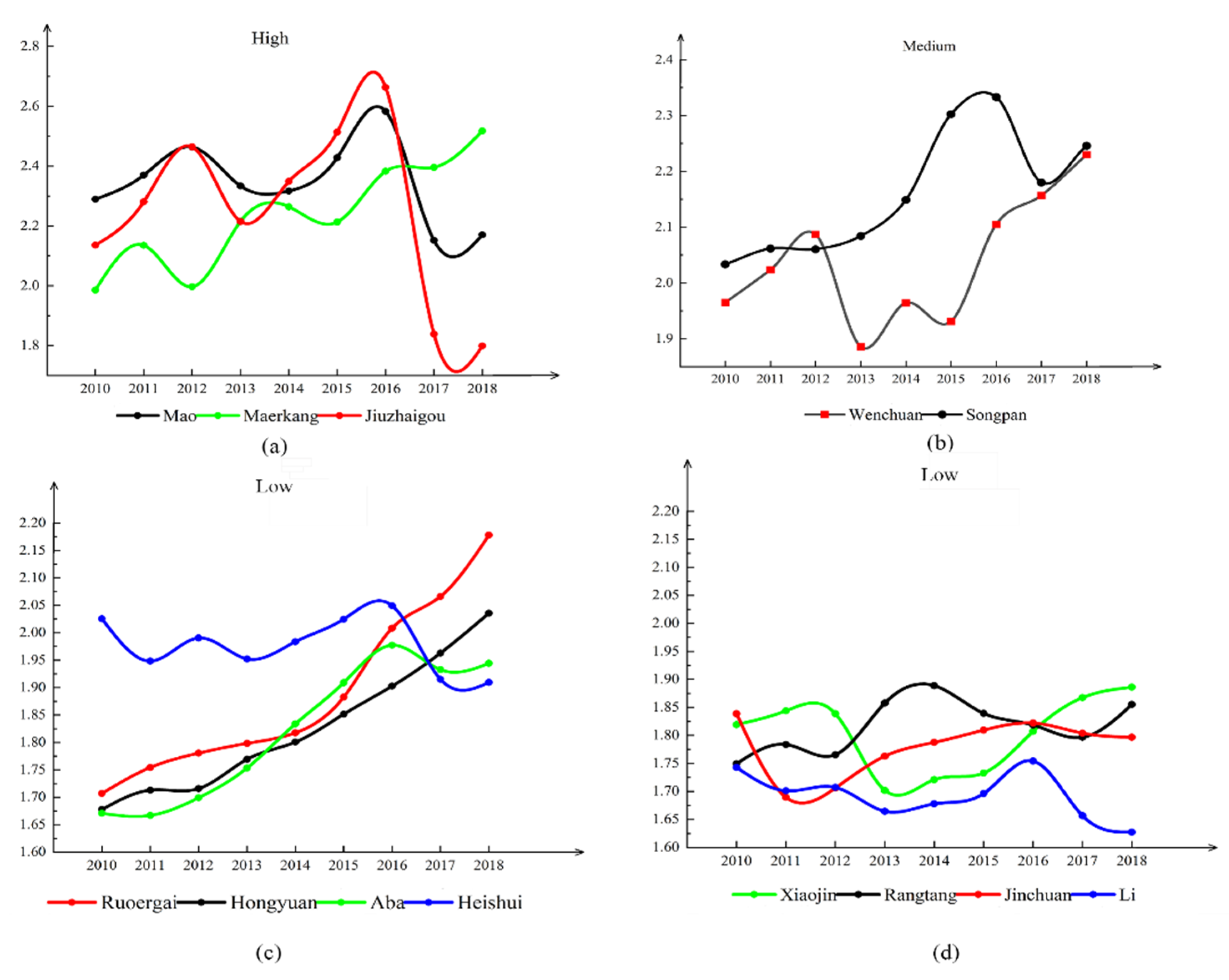


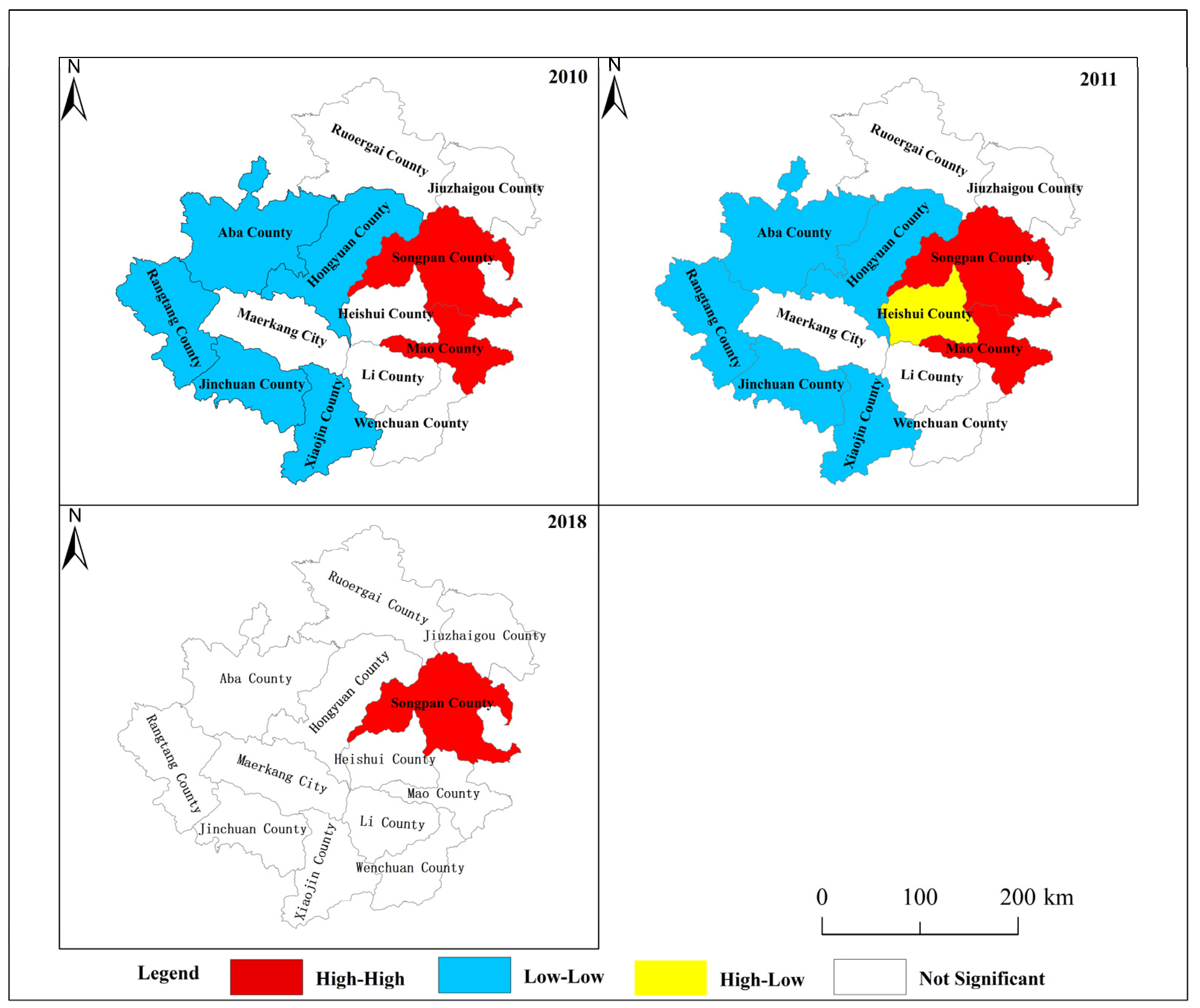
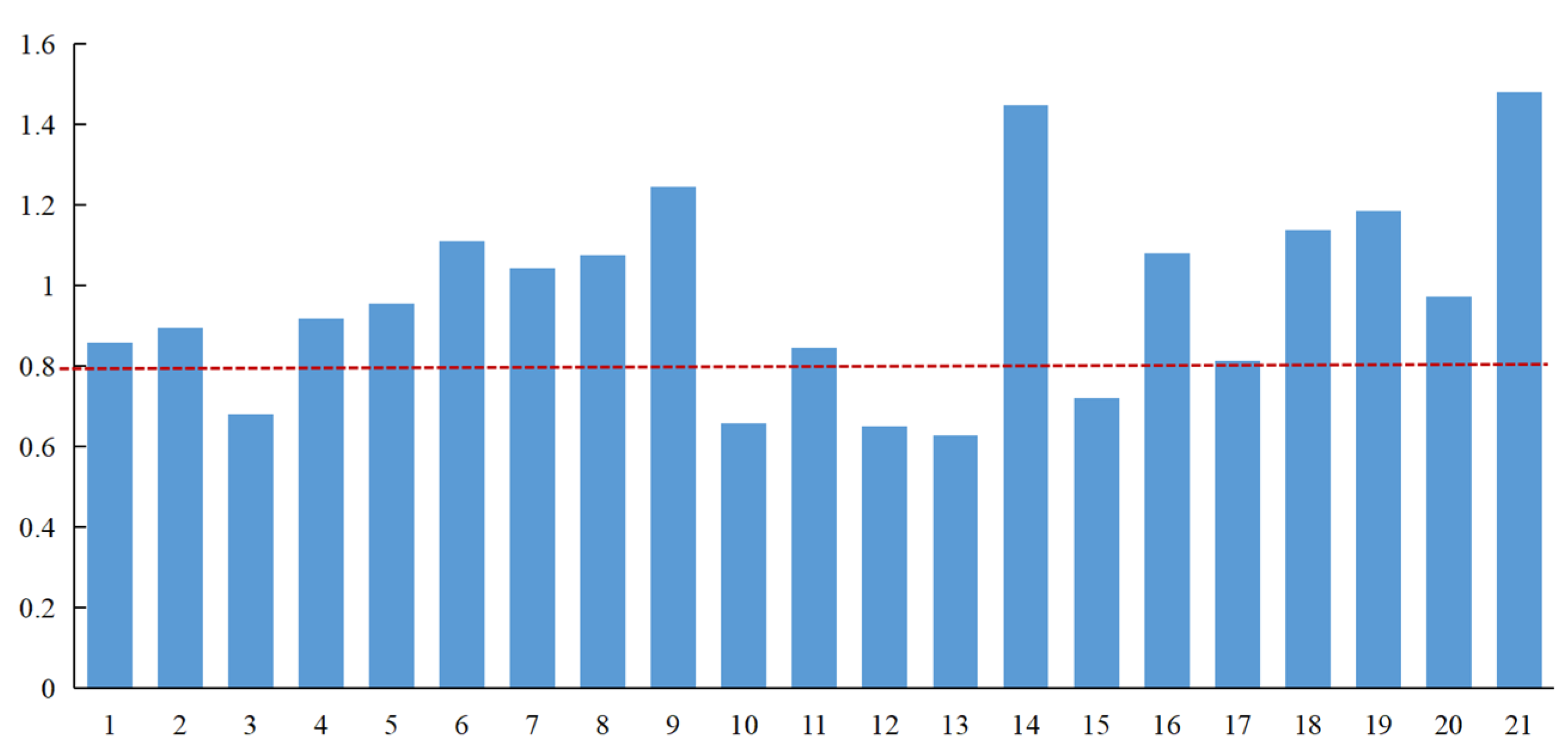
| Dimension | Variable | Variable Description | Category | Weight | |
|---|---|---|---|---|---|
| Environment | Coverage | Forest coverage (%) | Prevention | 5.41% | |
| Elevation | Average elevation (m) | Prevention | 7.01% | ||
| Land area | Arable land area per capita (ha/person) | Resistance | 3.04% | ||
| Economy | GDP | Local GDP per capita (CNY) | Prevention | 5.46% | |
| Industry structure | The proportion of tertiary industry in total GDP (%) | Prevention | 5.57% | ||
| Social consumer goods retail | Total retail sales of consumer goods per capita (CNY) | Prevention | 5.98% | ||
| Finance revenue | Local public finance revenue (ten thousand CNY) | Prevention | 8.17% | ||
| Savings | Residents’ savings per capita (CNY) | Prevention | 5.28% | ||
| Society | Students | Number of students on campus | Prevention | 4.02% | |
| Bed space | Number of beds in hospitals and health institutions per 1000 population/unit | Rescue | 6.26% | ||
| The doctor | Number of physicians per 1000 population | Rescue | 6.33% | ||
| Social labor | Employ labor (%) | Resistance, Rescue | 2.31% | ||
| Social Security | Population with health insurance (%) | Resistance | 2.23% | ||
| Infrastructure | Communication Equipment | Number of fixed phone users | Resistance, Rescue | 6.74% | |
| Public transport | Road mileage (km/sq km) | Resistance, Rescue | 5.41% | ||
| Electricity | Electricity consumption in society (ten thousand kwh) | Resistance | 7.43% | ||
| Social investment | Amount of investment in fixed assets of the whole society (ten thousand CNY) | Prevention, Resistance | 4.55% | ||
| Internet users | Number of internet users | Prevention, Resistance, Rescue | 8.79% | ||
| Disaster pressure | Debris flow | Hazardous spots of debris flow disaster per 10,000 people | 18.2% | ||
| Landslide | Hazardous spots of landslide disaster per 10,000 people | 28.5% | |||
| The collapse of the ground | Hazardous spots of the collapse of the ground per 10,000 people | 53.3% |
| Environment | Economy | Society | Infrastructure | |
|---|---|---|---|---|
| 2010 | 50.4% | 55.7% | 27.1% | 60.0% |
| 2011 | 50.6% | 54.4% | 33.4% | 59.8% |
| 2012 | 50.6% | 53.2% | 31.5% | 58.1% |
| 2013 | 50.1% | 49.1% | 34.7% | 57.5% |
| 2014 | 50.2% | 49.5% | 31.9% | 56.7% |
| 2015 | 50.2% | 49.6% | 35.2% | 54.8% |
| 2016 | 50.2% | 45.5% | 34.9% | 52.5% |
| 2017 | 51.0% | 43.8% | 37.5% | 48.8% |
| 2018 | 51.4% | 44.4% | 39.3% | 51.9% |
| Moran’s I | Mean | SD | z-Value | p-Value | |
|---|---|---|---|---|---|
| 2010 | 0.256 | −0.0833 | 0.0941 | 3.676 | 0.001 |
| 2011 | 0.270 | −0.0803 | 0.0900 | 3.895 | 0.001 |
| 2012 | 0.291 | −0.0911 | 0.0890 | 4.298 | 0.001 |
| 2013 | 0.228 | −0.0873 | 0.0920 | 3.424 | 0.001 |
| 2014 | 0.246 | −0.0800 | 0.0942 | 3.460 | 0.001 |
| 2015 | 0.296 | −0.0833 | 0.0909 | 4.245 | 0.001 |
| 2016 | 0.292 | −0.0830 | 0.0907 | 4.131 | 0.001 |
| 2017 | 0.075 | −0.0808 | 0.0925 | 1.685 | 0.057 |
| 2018 | 0.045 | −0.0863 | 0.167 | 1.660 | 0.070 |
| Dimension | Variable | Coefficient | VIP |
|---|---|---|---|
| Environment | Coverage | 0.222 | 0.856 |
| Elevation | −0.169 | 0.894 | |
| Land area | 0.059 | 0.679 | |
| Economy | GDP | 0.003 | 0.918 |
| Industry structure | 0.040 | 0.955 | |
| Social consumer goods retail | 0.171 | 1.110 | |
| Finance revenue | 0.225 | 1.041 | |
| Savings | −0.127 | 1.075 | |
| Society | Students | 0.023 | 1.244 |
| Bed space | 0.169 | 0.657 | |
| The doctor | 0.019 | 0.844 | |
| Social labor | 0.211 | 0.650 | |
| Social security | 0.064 | 0.628 | |
| Infrastructure | Communication devices | 0.411 | 1.447 |
| Public transport | 0.229 | 0.720 | |
| Electricity | 0.189 | 1.080 | |
| Social investment | 0.316 | 0.812 | |
| Internet users | 0.123 | 1.138 | |
| Disaster pressure | Debris flow | −0.539 | 1.184 |
| Landslide | −0.238 | 0.973 | |
| The collapse of the ground | −0.530 | 1.480 |
Publisher’s Note: MDPI stays neutral with regard to jurisdictional claims in published maps and institutional affiliations. |
© 2022 by the authors. Licensee MDPI, Basel, Switzerland. This article is an open access article distributed under the terms and conditions of the Creative Commons Attribution (CC BY) license (https://creativecommons.org/licenses/by/4.0/).
Share and Cite
Zhou, Y.; Su, Q.; Li, Y.; Li, X. Spatial-Temporal Characteristics of Multi-Hazard Resilience in Ecologically Fragile Areas of Southwest China: A Case Study in Aba. Int. J. Environ. Res. Public Health 2022, 19, 12018. https://doi.org/10.3390/ijerph191912018
Zhou Y, Su Q, Li Y, Li X. Spatial-Temporal Characteristics of Multi-Hazard Resilience in Ecologically Fragile Areas of Southwest China: A Case Study in Aba. International Journal of Environmental Research and Public Health. 2022; 19(19):12018. https://doi.org/10.3390/ijerph191912018
Chicago/Turabian StyleZhou, Ying, Qihao Su, Yulian Li, and Xingwei Li. 2022. "Spatial-Temporal Characteristics of Multi-Hazard Resilience in Ecologically Fragile Areas of Southwest China: A Case Study in Aba" International Journal of Environmental Research and Public Health 19, no. 19: 12018. https://doi.org/10.3390/ijerph191912018
APA StyleZhou, Y., Su, Q., Li, Y., & Li, X. (2022). Spatial-Temporal Characteristics of Multi-Hazard Resilience in Ecologically Fragile Areas of Southwest China: A Case Study in Aba. International Journal of Environmental Research and Public Health, 19(19), 12018. https://doi.org/10.3390/ijerph191912018








